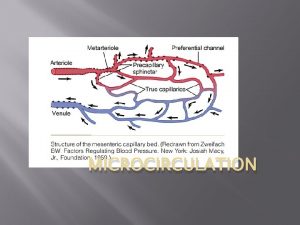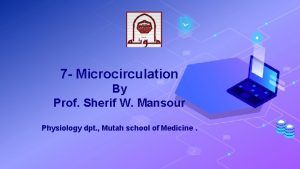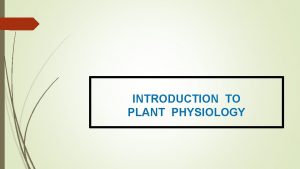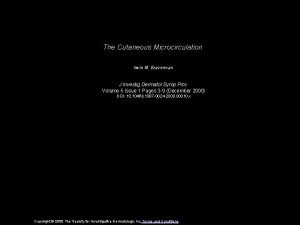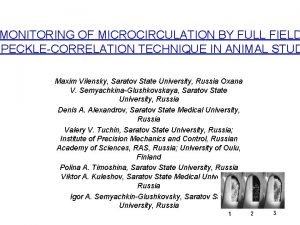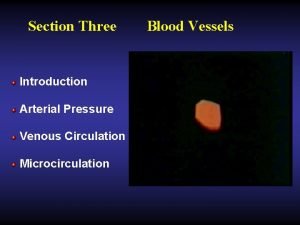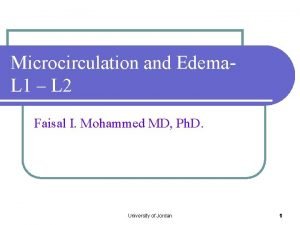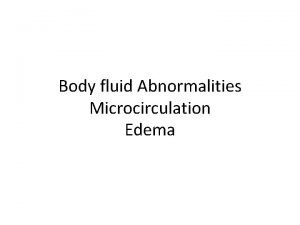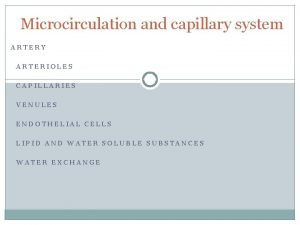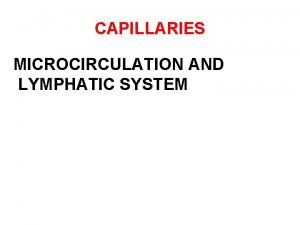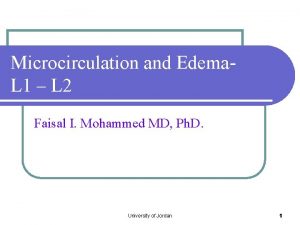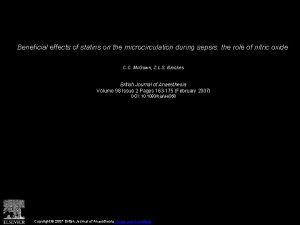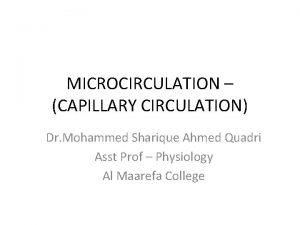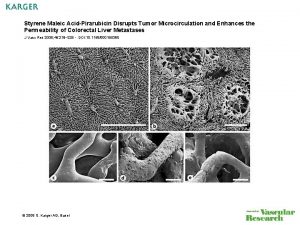Physiology of microcirculation Microcirculation The microcirculation is the























- Slides: 23

Physiology of microcirculation

Microcirculation ● The microcirculation is the blood flow through blood vessels smaller than 100 µm (i. e. arterioles, capillaries, and venules). ● Function: 1. Transport of cells, oxygen and other substances to/from the tissues 2. Regulation of body temperature

Microcirculation consists of 3 components: 1. Haemomycrocyrculation (arterioles, precapillares, postcapillares venules, arterioles-venules anastomosis) n 2. Substance’ transport to intercticium, where some hydrostatic and oncotic pressure creates n 3. Limphatic vessels – their walls more thin than in arteriales and don’t contain basal membrane. Intercellular cracks – they are the main way of penetration of tissue fluid into the lumen of lymphatic vessels n


Arterioles An arteriole is a small diameter (<20 μm, up to 5 -9 μm) blood vessel that extends and branches out from an artery and leads to capillaries. n Arterioles have thin muscular walls (usually one to two layers of smooth muscle) and are the primary site of vascular resistance. n In a healthy vascular system the endothelium, inner lining of arterioles and other blood vessels, is smooth and relaxed. This healthy condition is promoted by the ample production of nitric oxide in the endothelium. n Arteriola Metharteriola Shunt Arterial capillares Precapillary sphincter Venous capillares Postcapillary sphincter Venula

Total peripheral resistance refers to the cumulative resistance of the thousands of arterioles with precapillares in the body. n It is approximately equal to the resistance of the arterioles, since the arterioles are the chief resistance vessels in the body. n Total Peripheral Resistance = Mean Pressure //Cardiac. Output Mean. Arterial Pressure. . n n The total peripheral resistance of healthy lung arterioles is typically about 0. 15 to 0. 20 that of the body, so pulmonary artery mean blood pressures are typically about 0. 15 to 0. 20 of aortic mean blood pressures.

Capillary n n n Capillaries, are the smallest of a body's blood vessels, measuring 5 -10 μm. They connect arteries and veins, and most closely interact with tissues. Capillaries have walls composed of a single layer of cells, the endothelium. This layer is so thin that molecules such as oxygen, water and lipids can pass through them by diffusion and enter the tissues. Waste products such as carbon dioxide and urea can diffuse back into the blood to be carried away for removal from the body. Capillary permeability can be increased by the release of certain cytokines.

The Organization of a Capillary Bed Figure 21. 5 a, b

Types of Capillaries n There are three structural types of capillaries: 1. Continuous 2. Fenestrated 3. Sinusoids

Type of Capillaries: Continuous capillaries most abundant in the skin & muscles – Least permeable, lack pores – Endothelial cells provide an uninterrupted lining – Adjacent cells are connected with tight junctions – Intercellular clefts allow the passage of fluids n Continuous capillaries of the brain – Have tight junctions completely around the endothelium – Constitute the blood-brain barrier n

Type of Capillaries: Fenestrated n Fenestrated Capillaries – They have pores (fenestrations) – Found wherever active capillary absorption or filtrate occurs § Example: intestinal villi, ciliary process of eye, endocrine glands, glomeruli of kidney Characterized by: – Greater permeability than continuous capillaries

Type of Capillaries: Sinusoidal n Sinusoidal capillaries are modified, very permeable (leaky) capillaries. n They have a large lumens with large fenestrae. – Found only in the liver, bone marrow, lymphoid tissue and in some endocrine organs.

TYPES OF CAPILLARY n 1. Somatic. n 2. Visceral n 3. Sinusoidal

Capillary Beds: Microcirculation Vascular shunts – metarteriole – thoroughfare channel n True capillaries – 10 to 100 per capillary bed – branch off the metarteriole n Precapillary sphincter – Cuff of smooth muscle that surrounds each true capillary – Regulates blood flow into the capillary n Blood flow regulated by vasomotor nerves & chemical conditions n

Oxygen, CO 2, small solutes, nutrients move across capillaries primarily through diffusion. Concentration gradient Electrochemical Hydrostatic and Osmotic pressure

Fig 14. 9 14 -22

Morpho-functional properties of venous system n Veins are the vessels, which are carry out blood from organs, tissues to heart in right atrium. Only pulmonary vein carry out blood from lungs in left atrium. There are superficial (skin) and deep veins. They are very stretching and have a low elasticity. Valves are present in veins. Plexus venosus are storage of blood. Blood moving in veins under gravity.

Lymphatic system n The lymphatic system is a complex network of lymphoid organs, lymph nodes, lymph ducts, and lymph vessels that produce and transport lymph fluid from tissues to the circulatory system. n The lymphatic system is a major component of the immune system.

Morpho-functional properties of lymphatic system n n n Lymph system has capillaries, vessels, where present valves, lymphatic nodes. In lymphatic nodes are lymphopoiesis, depo of lymph, their function is barrierfilter. Lymph flow in vein system through the chest lymph ductus. Functions of lymph: 1. support of constant level of volume and components of tissue fluid; 2. transport of nutritive substances from digestive tract in venous system; 3. barrier-filter function. 4. take place in immunology reactions.

Lympathatic system n The lymphatic system has three primary functions. First of all, it returns excess interstitial fluid to the blood. n The second function of the lymphatic system is the absorption of fats and fat-soluble vitamins from the digestive system and the subsequent transport of these substances to the venous circulation. n The third and probably most well known function of the lymphatic system is defense against invading microorganisms and disease.



THANCK YOU!
 Microcirculation of spleen
Microcirculation of spleen Hổ sinh sản vào mùa nào
Hổ sinh sản vào mùa nào Diễn thế sinh thái là
Diễn thế sinh thái là đại từ thay thế
đại từ thay thế Vẽ hình chiếu vuông góc của vật thể sau
Vẽ hình chiếu vuông góc của vật thể sau Công thức tiính động năng
Công thức tiính động năng Tỉ lệ cơ thể trẻ em
Tỉ lệ cơ thể trẻ em Thế nào là mạng điện lắp đặt kiểu nổi
Thế nào là mạng điện lắp đặt kiểu nổi Lời thề hippocrates
Lời thề hippocrates Vẽ hình chiếu đứng bằng cạnh của vật thể
Vẽ hình chiếu đứng bằng cạnh của vật thể Quá trình desamine hóa có thể tạo ra
Quá trình desamine hóa có thể tạo ra Các môn thể thao bắt đầu bằng tiếng nhảy
Các môn thể thao bắt đầu bằng tiếng nhảy Sự nuôi và dạy con của hươu
Sự nuôi và dạy con của hươu Hát kết hợp bộ gõ cơ thể
Hát kết hợp bộ gõ cơ thể Dot
Dot điện thế nghỉ
điện thế nghỉ Thế nào là sự mỏi cơ
Thế nào là sự mỏi cơ Trời xanh đây là của chúng ta thể thơ
Trời xanh đây là của chúng ta thể thơ Phản ứng thế ankan
Phản ứng thế ankan Chó sói
Chó sói Thiếu nhi thế giới liên hoan
Thiếu nhi thế giới liên hoan Fecboak
Fecboak Một số thể thơ truyền thống
Một số thể thơ truyền thống Thế nào là hệ số cao nhất
Thế nào là hệ số cao nhất
























